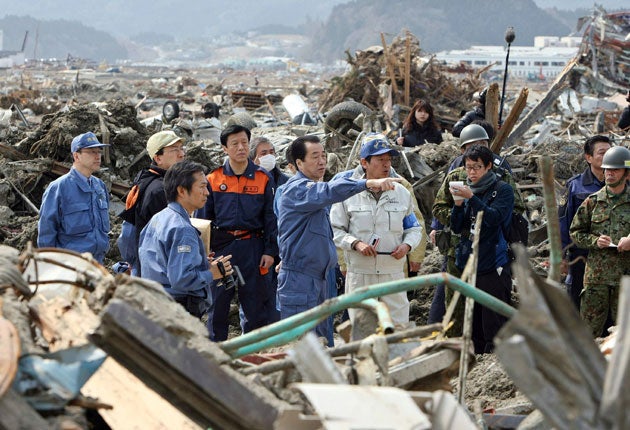Japan's PM visits town that was washed away
New crack discovered in Fukushima nuclear plant maintenance pit which has been allowing radiation to seep into the sea

Japan's prime minister surveyed the devastation yesterday as he paid his first visit to one of the towns destroyed by the tsunami.
His trip coincided with news that a crack had been discovered at the stricken Fukushima nuclear plant that was allowing highly radioactive water to leak into the sea.
The Daiichi nuclear complex has been spewing out radioactivity since 11 March when a magnitude 9.0 earthquake and ensuing tsunami knocked out power, disabling cooling systems and allowing radiation to seep from the reactors.
Prime Minister Naoto Kan went to the plant and flew over the tsunami-damaged coast soon after the wave hit, but yesterday was the first time he had set foot in one of the devastated towns.
Dressed in the blue overalls that have become a uniform for officials, Mr Kan stopped in Rikuzentakata, where the town hall is one of the few buildings standing. Its windows have been blown out and a tangle of metal and debris is piled in front of it.
After bowing his head for a minute's silence in front of the building, Mr Kan met the town's mayor, whose 38-year-old wife was swept away by the wave and is still missing. Officials fear that 25,000 people may have been killed in the disaster.
Yesterday's leak was from a newly discovered crack in a maintenance pit on the edge of the Fukushima complex. The crack was apparently caused by the quake and may have been leaking since then, said Osamu Yokokura, a spokesman for the Tokyo Electric Power Company (Tepco), which runs the plant. Measurements showed the air above the pit contained more than 1,000 millisieverts per hour of radioactivity – twice the level that is known to cause cancers. Two feet (60cm) away, however, that figure dropped to 400 millisieverts. Radiation quickly disperses in both air and water, and experts say it would be quickly diluted by the Pacific.
Radioactive iodine-131 at concentrations higher than the legal limit was first detected in water off the plant more than a week ago. Readings released last Monday showed the contamination was spreading. It wasn't immediately clear whether workers fighting to bring the reactors under control were exposed.
People living within 12 miles (20km) of the plant have been moved out of the area and no fishing is allowed in waters around the plant.
People working at the plant are most at risk of radiation exposure. Tepco has acknowledged that the tsunami destroyed many of the gauges used to measure radiation, forcing workers to share. But more gauges have now been delivered to the site. One crew member said yesterday that the plant had also run out of the nylon protective booties that go over shoes.
"We only put on something like plastic garbage bags you can buy at a convenience store and seal them with masking tape," he told the Mainchi newspaper.. Such interviews are rare and always anonymous. The worker also revealed that the tsunami had littered the plant with dead fish which were attracting birds.
Radiation concerns have rattled the Japanese public, struggling to piece together their lives after the tsunami. Three weeks on, more than 165,000 people are living in shelters, while 260,000 homes do not have running water and 170,000 are without power. There is growing frustration among people with houses in the evacuation zone and some have been sneaking back. Government officials have warned that there are no plans to lift the evacuation order.
Thousands are still awaiting news of loved ones. More than 15,500 people are missing. US and Japanese troops found 50 bodies on Friday during a coastline search. So far, 11,800 deaths have been confirmed.
A dog spotted adrift on a floating rooftop was winched to safety by a helicopter crew.
Join our commenting forum
Join thought-provoking conversations, follow other Independent readers and see their replies
Comments
Bookmark popover
Removed from bookmarks